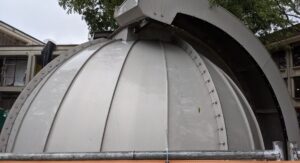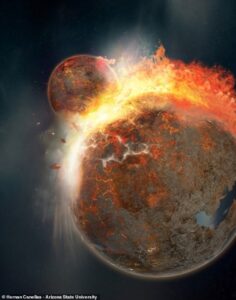Ever since Albert Einstein showed that space and time can be dented, warped, and stretched like an old mattress in a cheap motel, cosmologists have stared and pondered what kind of food our universe most closely resembles in terms of shape.
Is it shaped like an endless Pringle, spiraling upwards and outwards forever into eternity? Could it be a perfectly flat pizza if you ignore the bumps of the galactic pepperoni and dark matter cheese? Maybe it’s more like a spicy meatball that curves back until it meets on all sides.
Or just maybe it’s more like a donut that forms closed loops in multiple dimensions. An international team of cosmologists, who recently formed a group called the COMPACT Collaboration, analyzed the glow left over from the Big Bang and concluded that nothing in their models rules out such a cosmic landscape, if at least it curves in the right way.
Since “twisted space doughnut” isn’t (yet) a bona fide mathematical term, researchers use the term 3-torus to describe the mind-boggling possibility of stabbing yourself in the back of the head with a stick several tens of billions of light years long, no matter which way you’re facing .
Yes, you read that right. Put another way, our universe could be one giant carnival funhouse where, instead of a series of mirrors, spacetime bends in every direction, allowing you – in theory – to see your own back pockets if you squint hard enough .
It’s a tantalizing possibility that has been revisited over the years, and not just because of physicists’ penchant for gourmet desserts. Exotic shapes on a massive scale could point us to the physics of how our universe emerged from the seed of… well, something.
Roughly 13.8 billion years ago, everything we can see (and for that matter everything we can’t) was crammed into an incredibly small space that science has yet to describe, requiring a mixture of quantum physics and general relativity. which we have yet to land on.
What i can the moments when space expands and the material in it cools are described. At some point, the universe expanded enough for some of its electromagnetic radiation to escape the dense crowds of electrons and solidifying atomic nuclei.
Some of those free photons have managed to avoid collisions ever since, happily humming along as expanding space stretches the light into long, cool noodles of microwave radiation.
This low-energy “glow” is called the cosmic microwave background (CMB). Mapping the subtle variations in the CMB glow can give us a rough idea of what the early moments of expansion looked like. While this is convenient for some models, the scale and patterns in the map depend heavily on how the space is shaped, leaving other theories open.
If we lived in a giant pizza? All these fluctuations must exactly reflect the same scale. Do you have Pringle Universe? Light can bend in a way that makes the variations smaller than they appear. Meatballs? The light may have increased.
And if it’s a donut? The universe would be topologically flat, like a pizza, with only repeating patterns that could point to phenomena that break radical new ground in our quest to understand the origins of everything.
Unfortunately, clear signs of these closed loops of space and time are not yet visible in the CMB. Before you cry “case closed and where’s my side of the galactic garlic bread?”, the members of the COMPACT Collaboration argue that we shouldn’t be so hasty.
In their inaugural paper, the team argued that some exotically shaped universes based on the more twisted forms of the 3-torus are still compatible with the CMB.
Although the standard donut runs into problems at certain scales, we cannot so easily dismiss versions of the torus that distort the light in such a way that the patterns are distorted but still correlated.
The search for these correlations may yet reveal exotic features of the overall shape of our universe, perhaps with twists and curves that require new physics to explain.
Maybe Homer Simpson’s theory that the cartoon Stephen Hawking is so intrigued isn’t so absurd after all.
This research was published in Physical examination letters.



